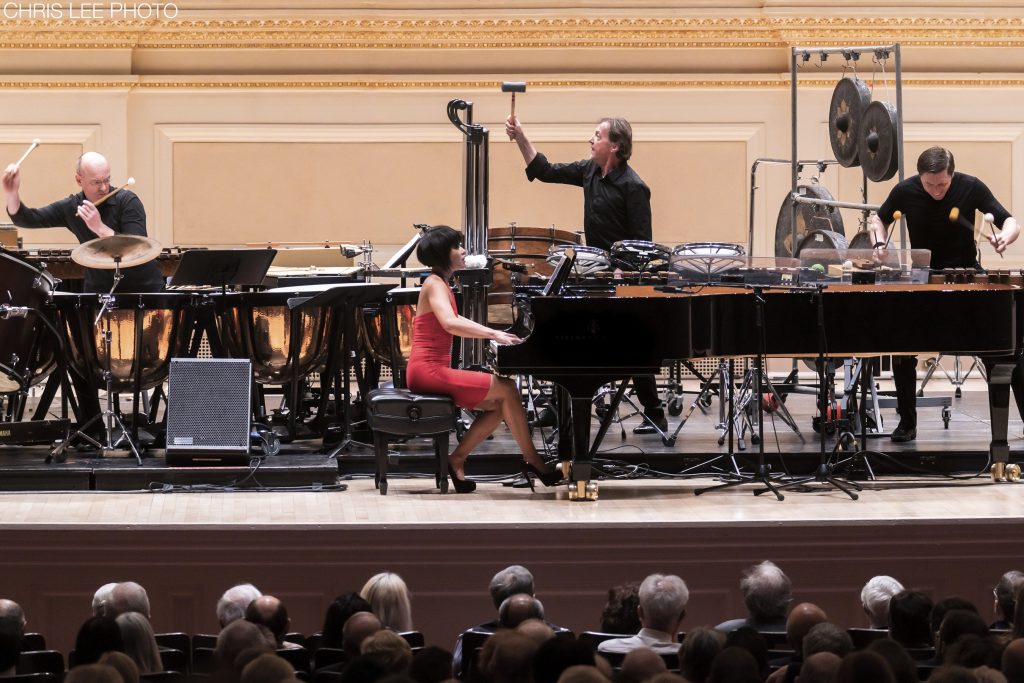Joshua Barone, New York Times
Look up “Is the piano a percussion or string instrument?” online, and you’ll find an irreconcilable series of arguments for either side.
But on Friday night, the pianist Yuja Wang, in the first of her six Perspectives series concerts at Carnegie Hall this season, made a clear argument for the instrument as percussion: a versatile, but ultimately mechanical, contraption that makes music from hammers striking strings.
Her concert — an evening of works, some familiar and others much less so, arranged for only piano and percussion — was also a declaration that she would exploit the Perspectives platform to show New York City just what she was capable of beyond war-horse concertos and reliably impressive solo recitals.
What she is more than capable of, it turns out, is ceding the stage to other musicians. Despite all the attention Ms. Wang gets for pyrotechnic virtuosity and, I have to say, bold fashion, she is a remarkably unpretentious partner when she plays with peers like the violinist Leonidas Kavakos (they will share a Carnegie recital in February) and, in the case of Friday, the percussionist Martin Grubinger.

Yuja Wang and Martin Grubinger performs at Carnegie Hall, 10/26/18. Photo by Chris Lee Photographer / chrisleephotographer.com
The lanky Mr. Grubinger, an Austrian virtuoso who was brilliantly athletic in John Corigliano’s percussion concerto “Conjurer” with the New York Philharmonic in 2016, shared billing with Ms. Wang in the Carnegie program, and commanded the stage with equal authority. He wields four mallets with such speed they tend to blur; yet his articulation couldn’t be clearer. Neither he nor Ms. Wang seemed to drop a note all night.
Joining them were three additional percussionists — including Mr. Grubinger’s father, Martin Grubinger Sr., who had arranged the four works on Friday’s program in ways that cleverly retained their musical integrity while drawing out the vibrantly percussive spirit at the heart of each piece. His arrangements were particularly revelatory in two of the evening’s most famous works: Bartok’s Sonata for Two Pianos and Percussion, and Stravinsky’s “The Rite of Spring.”
The Bartok, missing one piano, was no less melodic. Yet its intricate, varied rhythms were more exposed and amplified, and altogether electrifying. Ms. Wang, hammering ostinato chords with immense force that belied her small frame, didn’t have the look of a soloist with accompaniment, but of a percussionist among others in an ensemble.
And the Stravinsky, stripped of its full orchestra, was more grounded and ritualistic than I’ve ever heard it. What a breath of fresh air this was in a season unusually saturated with the ballet score: Where the New York Philharmonic’s “Rite” in September was labored and unmenacing, this one was terrifying and ultimately more reflective of the primitive, sacrificial dance. Ms. Wang, a mighty substitute for the work’s string instruments, demonstrated how the piece has always used violins as thinly veiled percussion.
Weighty and climactic, “Rite” often closes programs for a reason. So it was unfortunate that it didn’t on Friday. Rather, the concert continued, awkwardly, with Arturo Márquez’s 10-minute “Danzón No. 2,” comparatively lighter fare with tango rhythms and crowd-pleasing color.
But that was just one flaw in a daring and declarative evening that ultimately bodes well for Ms. Wang’s remaining Perspectives concerts. There will be standard repertory (a Prokofiev piano concerto, a Rachmaninoff chamber work), but also opportunities to push the boundaries of piano programming. If Friday seemed at all adventurous, just wait until she returns in February for an anything-goes romp with the classical music comedy duo Igudesman & Joo.
